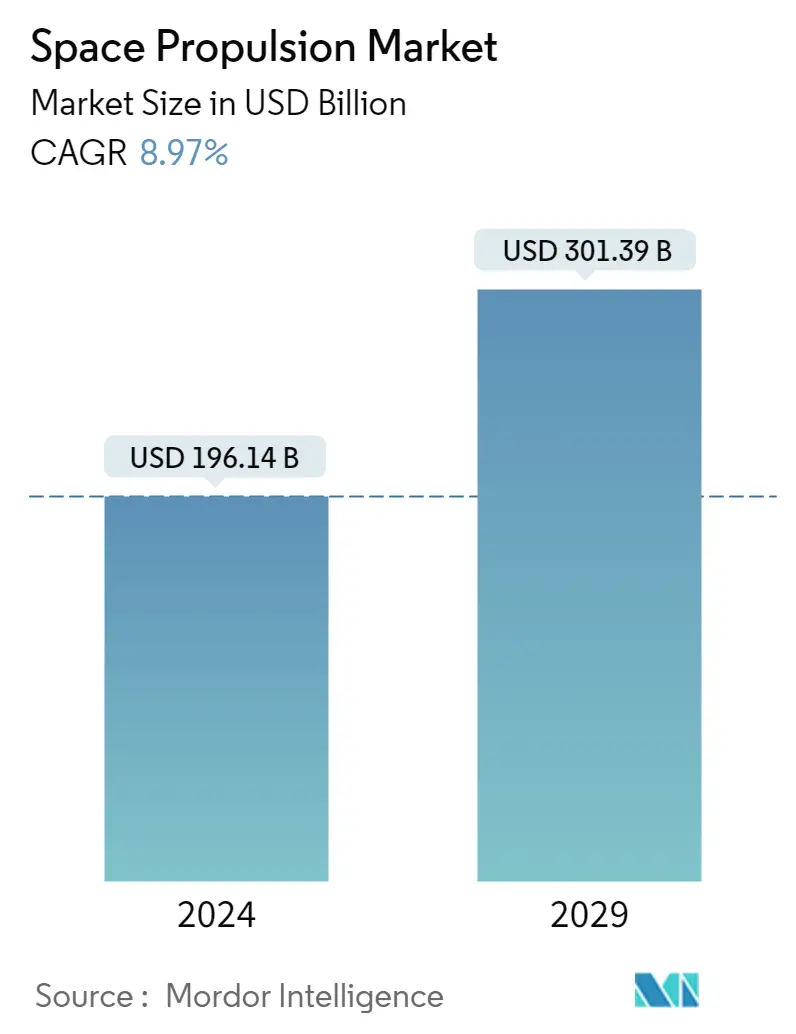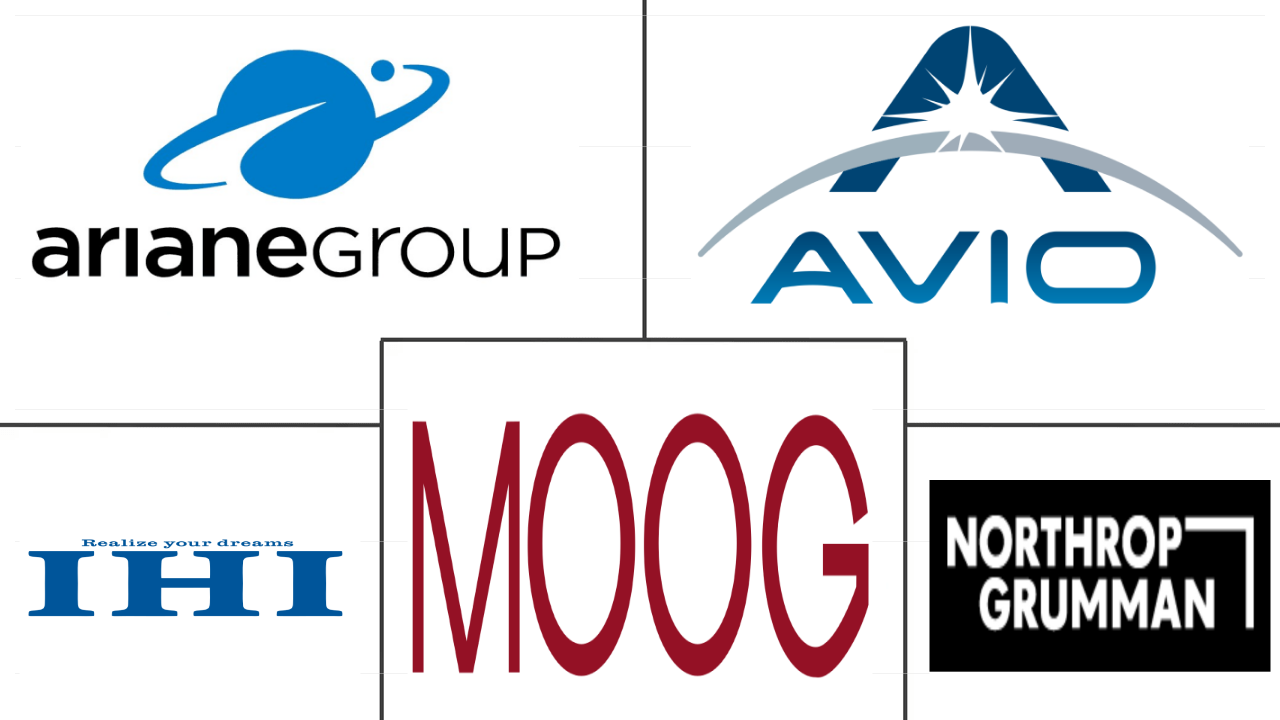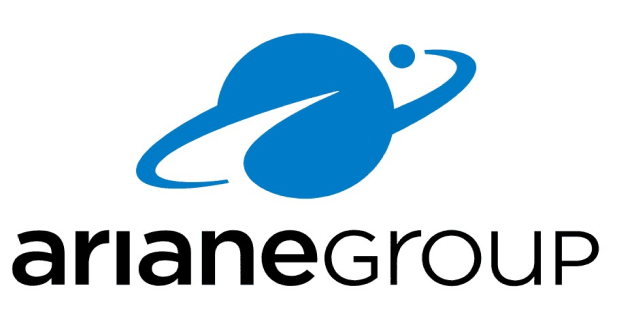Market Size of space propulsion Industry

|
|
Study Period | 2017 - 2029 |
|
|
Market Size (2024) | USD 196.14 Billion |
|
|
Market Size (2029) | USD 301.39 Billion |
|
|
Largest Share by Propulsion Tech | Liquid Fuel |
|
|
CAGR (2024 - 2029) | 8.97 % |
|
|
Largest Share by Region | North America |
Major Players |
||

|
||
|
*Disclaimer: Major Players sorted in no particular order |
Space Propulsion Systems Market Analysis
The Space Propulsion Market size is estimated at USD 196.14 billion in 2024, and is expected to reach USD 301.39 billion by 2029, growing at a CAGR of 8.97% during the forecast period (2024-2029).
196.14 Billion
Market Size in 2024 (USD)
301.39 Billion
Market Size in 2029 (USD)
12.51 %
CAGR (2017-2023)
8.97 %
CAGR (2024-2029)
Largest Market by Propulsion Tech
73.93 %
value share, Liquid Fuel, 2022
Because of its high efficiency, controllability, reliability, and long lifespan, liquid fuel-based propulsion technology is becoming an ideal choice for space missions. It can be used in various orbit classes for satellites.
Second Largest Market by Propulsion Tech
73.93 %
value share, Liquid Fuel, 2022
Eco-friendly electric propulsion systems are a growing trend in line with the use of smart manufacturing materials for the development of small satellites and other green emission initiatives.
Largest Market by Region
69.89 %
value share, North America, 2022
The increasing investments in satellite equipment to enhance the defense and surveillance capabilities, the construction of critical infrastructure, and the rise in law enforcement agencies using satellite systems are the key drivers in the market.
Fastest-Growing Market by Region
69.89 %
value share, North America, 2022
The Rest of the World segment is expected to experience significant growth during the forecast period due to the rise of internet-based services in the Middle East & Africa.
Leading Market Player
28.19 %
market share, Ariane Group, 2022

Aerojet Rocketdyne Holdings Inc. is the leading player in the market. The company is a manufacturer of rocket and electric propulsive systems for space, defense, civil, and commercial applications.
Consistent adoption of gas-based propulsion drives to lead the segment
- To change the velocity and direction, the satellite's propulsion system plays an important role. It is also used to coordinate the position of the spacecraft in orbit. After entering into orbit, the spacecraft needs attitude control which helps to correctly align its direction with respect to the Earth and the Sun. In some cases, satellites need to be moved from one orbit, and without their ability to adjust to their orbit, the life of satellites is considered to be over. Therefore, the importance of propulsion systems is expected to drive the market growth.
- Various types of propellants are used for different purposes. Liquid propellants use rocket engines that use liquid fuel. Gas propellants can also be used but are not common due to their low density and difficulty in applying conventional pumping methods. The chemical propulsion systems that enabled movements proved to be efficient and reliable. These include hydrazine systems, single or twin propulsion systems, hybrid systems, cold/hot air systems, and solid propellants. They are used when strong thrust or rapid maneuvering is required. Therefore, chemical systems remain the space propulsion technology of choice when their total impulse capacity is sufficient to meet the mission requirements.
- Electric propulsion is commonly used to hold stations for commercial communication satellites, and it is the main propulsion of some space science missions due to their high specific impulses. Northrop Grumman Corporation, Moog Inc., Sierra Nevada Corporation, SpaceX, and Blue Origin are some of the major providers of propulsion systems. The new launch of satellites is expected to accelerate market growth during the forecast period.
The growing interest of governments and private players in space exploration have fueled the expansion of this market
- The global market for satellite propulsion systems witnessed robust growth in recent years, driven by the increasing demand for satellite deployments across various sectors. North America has emerged as a dominant player in the global space propulsion market, mainly due to the presence of established space agencies such as NASA and private companies like SpaceX, Blue Origin, and Boeing. These entities have undertaken ambitious space missions and satellite deployments, driving the demand for advanced propulsion systems. NASA is also working on the Solar Electric Propulsion project, which aims to extend the duration and capabilities of ambitious discoveries and science missions.
- Asia-Pacific has witnessed a rapid expansion of its space capabilities in recent years. Countries like China, India, and Japan have made significant strides in space technology and satellite manufacturing, positioning themselves as formidable players in the global market. In May 2022, Kongtian Dongli, a Chinese satellite electric propulsion company, secured multi-million yuan angel round financing amid a proliferation of Chinese constellation plans.
- Europe has a strong tradition of collaboration in space exploration through organizations like the ESA. ESA's partnerships with multiple member states have resulted in significant advancements in space technology, satellite manufacturing, and launch capabilities. In February 2023, IENAI SPACE, an in-space mobility provider based in Spain, received two ESA contracts within the General Support Technology Program to mature and further develop ATHENA (Adaptable THruster based on Electrospray powered by NAnotechnology) propulsion systems.
Space Propulsion Industry Segmentation Space Propulsion Systems Industry Segmentation
Electric, Gas based, Liquid Fuel are covered as segments by Propulsion Tech. Asia-Pacific, Europe, North America are covered as segments by Region.
- To change the velocity and direction, the satellite's propulsion system plays an important role. It is also used to coordinate the position of the spacecraft in orbit. After entering into orbit, the spacecraft needs attitude control which helps to correctly align its direction with respect to the Earth and the Sun. In some cases, satellites need to be moved from one orbit, and without their ability to adjust to their orbit, the life of satellites is considered to be over. Therefore, the importance of propulsion systems is expected to drive the market growth.
- Various types of propellants are used for different purposes. Liquid propellants use rocket engines that use liquid fuel. Gas propellants can also be used but are not common due to their low density and difficulty in applying conventional pumping methods. The chemical propulsion systems that enabled movements proved to be efficient and reliable. These include hydrazine systems, single or twin propulsion systems, hybrid systems, cold/hot air systems, and solid propellants. They are used when strong thrust or rapid maneuvering is required. Therefore, chemical systems remain the space propulsion technology of choice when their total impulse capacity is sufficient to meet the mission requirements.
- Electric propulsion is commonly used to hold stations for commercial communication satellites, and it is the main propulsion of some space science missions due to their high specific impulses. Northrop Grumman Corporation, Moog Inc., Sierra Nevada Corporation, SpaceX, and Blue Origin are some of the major providers of propulsion systems. The new launch of satellites is expected to accelerate market growth during the forecast period.
| Propulsion Tech | |
| Electric | |
| Gas based | |
| Liquid Fuel |
| Region | |||||||||||
| |||||||||||
| |||||||||||
| |||||||||||
|
Space Propulsion Market Size Summary
The space propulsion systems market is poised for significant growth, driven by the increasing demand for satellite deployments and advancements in space technology. Propulsion systems are crucial for altering the velocity and direction of spacecraft, as well as for maintaining their position in orbit. This necessity underscores the importance of propulsion systems in extending the operational life of satellites. The market is characterized by the use of various propellants, including liquid and chemical systems, which are preferred for their efficiency and reliability in providing strong thrust and rapid maneuvering capabilities. Electric propulsion is also gaining traction, particularly for commercial communication satellites and space science missions, due to its high specific impulse. Major players in the industry, such as Northrop Grumman Corporation, Moog Inc., Sierra Nevada Corporation, SpaceX, and Blue Origin, are driving innovation and expansion in the market.
Regionally, North America leads the global space propulsion market, bolstered by the presence of established space agencies like NASA and private companies such as SpaceX and Blue Origin. These entities are actively involved in ambitious space missions and satellite deployments, fueling demand for advanced propulsion systems. The Asia-Pacific region is experiencing rapid growth, with countries like China, India, and Japan making significant advancements in space technology and satellite manufacturing. Europe, through collaborations like those of the European Space Agency (ESA), continues to make strides in space exploration and technology development. The market is fairly consolidated, with a few key players dominating the landscape. Recent developments, such as NASA's contracts with Blue Origin and Thales Alenia Space, highlight ongoing investments and innovations in space propulsion systems, further propelling market growth.
Space Propulsion Market Size - Table of Contents
-
1. MARKET SEGMENTATION (includes market size in Value in USD, Forecasts up to 2029 and analysis of growth prospects)
-
1.1 Propulsion Tech
-
1.1.1 Electric
-
1.1.2 Gas based
-
1.1.3 Liquid Fuel
-
-
1.2 Region
-
1.2.1 Asia-Pacific
-
1.2.1.1 By Country
-
1.2.1.1.1 Australia
-
1.2.1.1.2 China
-
1.2.1.1.3 India
-
1.2.1.1.4 Japan
-
1.2.1.1.5 New Zealand
-
1.2.1.1.6 Singapore
-
1.2.1.1.7 South Korea
-
-
-
1.2.2 Europe
-
1.2.2.1 By Country
-
1.2.2.1.1 France
-
1.2.2.1.2 Germany
-
1.2.2.1.3 Russia
-
1.2.2.1.4 United Kingdom
-
-
-
1.2.3 North America
-
1.2.3.1 By Country
-
1.2.3.1.1 Canada
-
1.2.3.1.2 United States
-
-
-
1.2.4 Rest of World
-
1.2.4.1 By Country
-
1.2.4.1.1 Brazil
-
1.2.4.1.2 Iran
-
1.2.4.1.3 Saudi Arabia
-
1.2.4.1.4 United Arab Emirates
-
1.2.4.1.5 Rest of World
-
-
-
-
Space Propulsion Market Size FAQs
How big is the Space Propulsion Market?
The Space Propulsion Market size is expected to reach USD 196.14 billion in 2024 and grow at a CAGR of 8.97% to reach USD 301.39 billion by 2029.
What is the current Space Propulsion Market size?
In 2024, the Space Propulsion Market size is expected to reach USD 196.14 billion.

